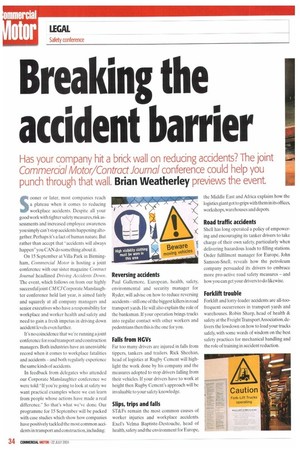Breaking the accident barrier
Page 34

Page 37

If you've noticed an error in this article please click here to report it so we can fix it.
Has your company hit a brick wall on reducing accidents? The joint
Commercial Motor/Contract Journal conference could help you
punch through that wall. Brian Weatherley previews the event.
Sooner or later, most companies reach a plateau when it comes to reducing workplace accidents. Despite all your good work with tighter safety measures, risk assessments and increased employee awareness you simply can't stop accidents happening altogether. Perhaps it's a fact of human nature. But rather than accept that "accidents will always happen" you CAN do something about it.
On 15 September at Villa Park in Birmingham, Commercial Motor is hosting a joint conference with our sister magazine Contract Journal headlined Driving Accidents Down. The event, which follows on from our highly successful joint CM/CT Corporate Manslaughter conference held last year, is aimed fairly and squarely at all company managers and senior executives who have a responsibility for workplace and worker health and safety and need to gain a fresh impetus in driving down accident levels even further.
It's no coincidence that we're running a joint conference for road transport and construction managers. Both industries have an unenviable record when it comes to work place fatalities and accidents — and both regularly experience the same kinds of accidents.
In feedback from delegates who attended our Corporate Manslaughter conference we were told: "If you're going to look at safety we want practical examples where we can learn from people whose actions have made a real difference." So that's what we've done. Our programme for 15 September will be packed with case studies which show how companies have positively tackled the most common accidents in transport and construction, including:
Reversing accidents
Paul Gallemore. European, health, safety, environmental and security manager for Ryder, will advise on how to reduce reversing accidents — still one of the biggest killers in road transport yards. He will also explain the role of the banksman. If your operation brings trucks into regular contact with other workers and pedestrians then this is the one for you.
Falls from HGVs
Far too many drivers are injured in falls from tippers, tankers and trailers, Rick Sheehan, head of logistics at Rugby Cement will highlight the work done by his company and the measures adopted to stop drivers falling from their vehicles. If your drivers have to work at height then Rugby Cement's approach will be invaluable to your safety knowledge.
Slips, trips and falls
ST&Fs remain the most common causes of worker injuries and workplace accidents, Exel's Velma Baptiste-Destouche, head of health, safety and the environment for Europe. the Middle East and Africa explains how the logistics giant got to grips with them in its offices, workshops, warehouses and depots.
Road traffic accidents
Shell has long operated a policy of empowering and encouraging its tanker drivers to take charge of their own safety, particularly when delivering hazardous loads to filling stations. Order fulfilment manager for Europe, John Samson-Snell. reveals how the petroleum company persuaded its drivers to embrace more pro-active road safety measures — and how you can get your drivers to do likewise.
Forklift trouble
Forklift and lorry-loader accidents are all-toofrequent occurrences in transport yards and warehouses. Robin Sharp, head of health & safety at the Freight Transport Association, delivers the lowdown on how to load your trucks safely, with some words of wisdom on the best safety practices for mechanical handling and the role of training in accident reduction.
Managing the accident maze
Following a major company-wide review of how it handled the aftermath of workplace accidents and incidents, Wincanton has seen a significant reduction in claims and the amount of money it has paid out in compensation. flow did they do it? Group health & safety manager Sean Cusack provides the answers.
Working at height
Late last year the Health & Safety Executive issued a consultation document on how its current Work at Height regulations might be improved or amended. Input from the road transport sector is a key part of that process.The HSE's Ian Greenwood will outline the current regulations and explain the timetable leading up to the forthcoming publication of the findings arising from the consultation. In addition to these speakers and case studies you'll hear the client's perspective on maintaining site safety from BAA Projects and how the Controlled Demolition Group has "demolished the excuses" for not putting safety at the top of any management agenda. •






























































































































































































